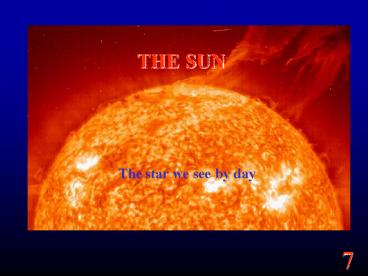THE SUN PowerPoint PPT Presentation
1 / 27
Title: THE SUN
1
THE SUN
- The star we see by day
2
Goals
- Summarize the overall properties of the Sun.
- What are the different parts of the Sun?
- Where does the light we see come from?
- The scientific method solar neutrinos.
3
The Sun, Our Star
- The Sun is an average star.
- From the Sun, we base our understanding of all
stars in the Universe. - No solid surface.
4
Vital Statistics
- Radius 100 x Earth (696,000 km)
- Mass 300,000 x Earth (1.99 x 1030 kg)
- Surface temp 5,800 K
- Core temp 15,000,000 K
- Luminosity 4 x 1026 Watts
- Solar Day
- 24.9 Earth days (equator)
- 29.8 Earth days (poles)
5
Interior Properties
- Core 20 x density of iron
- Surface 10,000 x less dense than air
- Average density Jupiter
- Core 15,000,000 K
- Surface 5800 K
6
Scientific Method
- How do we know this stuff?
- Three examples
- Fusion in the core (core temperature).
- Different zones in interior.
- Solar activity and Earth
7
1. The Core
- Scientific Method
- Observations
- Make hypothesis (a model)
- Models make predictions
- Test predictions
- Compare results of predictions with observations
- Revise model if necessary.
8
Testing the Core
- Observe Suns
- Mass (how?)
- Composition (how?)
- Radius
- Use physics to make a model Sun.
- Predict
- Surface temp/density (how do you test?)
- Surface Luminosity (how do you test?)
- Core temp/density ? Fusion Rate ? neutrino rate
(test?)
9
In The Core
- Density 20 x density of Iron
- Temperature 15,000,000 K
- Hydrogen atoms fuse together.
- Create Helium atoms.
10
Nuclear Fusion
- 4H ? He
- The mass of 4 H nuclei (4 protons)
- 4 x (1.6726 x10-27 kg) 6.690 x 10-27 kg
- The mass of He nuclei 6.643 x 10-27 kg
- Where does the extra 4.7 x 10-29 kg go?
- ENERGY! ? E mc2
- E (4.7 x 10-29 kg ) x (3.0 x 108 m/s)2
- E hc/l ? l 4.6 x 10-14 m (gamma rays)
- So 4H ? He light!
11
2. Helioseismology
- Continuous monitoring of Sun.
- Ground based observatories
- One spacecraft (SOHO)
- Surface of the Sun is ringing
- Sound waves cross the the solar interior and
reflect off of the surface (photosphere).
12
Solar Interior
- Core
- Only place with fusion
- Radiation Zone
- Transparent
- Convections Zone
- Boiling hot
13
Convection
- A pot of boiling water
- Hot material rises.
- Cooler material sinks.
- The energy from the pots hot bottom is
physically carried by the convection cells in the
water to the surface. - Same for the Sun.
14
Solar Cross-Section
- Progressively smaller convection cells carry the
energy towards surface. - See tops of these cells as granules.
15
The Photosphere
- This is the origin of the 5,800 K thermal
radiation we see. - l k/T k/(5800 K) ? l 480 nm (visible
light) - This is the light we see.
- Thats why we see this as the surface.
16
3. Solar Activity and Earth
- Is there a connection between Solar Activity and
Earths Climate? - Observation
- Little Ice Age
- Maunder Minimum
17
What is Solar Activity?
- Sunspots
- Magnetic Fields
- Coronal Mass Ejections
- Solar Wind
- Magnetic Storms
- Aurora
- Other effects?
18
Sunspots
- 11-year sunspot cycle.
- Center Umbra 4500 K
- Edge Penumbra 5500 K
- Photosphere 5800 K
19
Magnetic fields and Sunspots
- At kinks, disruption in convection cells.
- Sunspots form.
20
Magnetic fields and Sunspots
- Where magnetic fields pop out of Sun, form
sunspots. - Sunspots come in pairs.
21
Prominences
Hot low density gas emission lines
22
(No Transcript)
23
Corona and Solar Wind
- Hot, low density, gas emits the radiation we see
as the Corona 1,000,000 K - Solar Wind Like steam above our boiling pot of
water, the gas evaporates. - Carries away a million tons of Suns mass each
second! - Only 0.1 of total Suns mass in last 4.6 billion
years.
24
(No Transcript)
25
Solar Cycle
- Increase in solar wind activity
- - Coronal Mass Ejections
- Increase in Auroral displays on Earth
- Increase in disruptions on and around Earth.
Courtesy of SOHO/LASCO/EIT consortium.
26
(No Transcript)
27
Aurora
- The solar wind
- passes out
- through the
- Solar System.
- Consists of electrons, protons and other charged
particles stripped from the Suns surface. - Magnetic fields herd charged particles into
atmosphere at poles. - Charged particles excite electrons in atoms. ?
Light!
28
(No Transcript)
29
(No Transcript)
30
2003 CME
Oklahoma 10/29/2003
Credit E. Woldt
31
Homework 7
- Due Monday 30-Jan, Read Exoplanet articles plus
the website - http//www.howstuffworks.com/planet-hunting2.htm
- Why do we believe there are planets around other
stars? How have we detected them?

